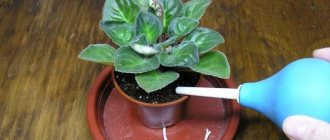Indoor plants cannot leave almost anyone indifferent. But the familiar violets cause delight and simply take your breath away with their beauty. Despite their relative unpretentiousness, they delight the eye with long-lasting flowering, and the riot of color and variety of shades drives you crazy. It got to the point that entire dynasties of violet growers appeared in our country, who dedicated significant areas of their homes to these plants. They exchange new varieties with each other, constantly replenish their assortment and rejoice at every new flower.
Description of the variety
Fire moths are violets, which will be described in this article. It has dark red single or semi-double flowers with a fairly wide red and white border. In this case, the border tends to change color as the bud blooms. Leaves are green. It grows quite easily.
Flowering is very long, peduncles are long. The rosette is very neat and symmetrical. Fire moths are bright and beautiful violets that can make you fall in love literally from the first flowering.
Features of care
Saintpaulias are very delicate plants that require special care. If all necessary conditions are provided, it can delight with its flowering for a very long time.
Saintpaulia Fire Moths respond best to average room temperatures that range around 20 degrees. It will be better if it is a couple of degrees cooler at night. This helps slow down tissue respiration processes, which will save organic matter.
Despite the fact that Fire Moths are a violet that originally grew on the African continent, like all of its close relatives, it tolerates cool weather much better than stuffy conditions. For example, if the temperature drops to 10 degrees, the plant may slow down, but will not lose viability. But when the temperature rises to 35 degrees, your pet may begin to get sick, which sometimes even leads to death.
Top 10 most popular varietal Saintpaulias
Meet the popular and very pretty varieties of violets that can decorate your home.
EK Blue-Eyed Russia
The author of this attractive Saintpaulia, which won prizes at exhibitions in the USA and Russia, is Elena Korshunova.
The variety does not require special care, loves cool weather, and reproduces well.
Flowers are large stars (5-7 cm), semi-double, double, pale blue. They form a beautiful hat. The petals are elongated, slightly wavy. There is a purple edging along the edge of the petals.
The leaves are green and pointed. The socket is large, smooth, standard.
Dn-Teen French
This bright, uniquely beautiful Saintpaulia was obtained by Dmitry Denisenko (Ukraine).
The flowers are large purple pansies with a light lilac wide fringe. It blooms luxuriously, brightly, for a long time. The border becomes narrower during the hot period.
The rosette is variegated, smooth, compact, standard.
Disadvantage - it happens that the flower stalks cannot withstand the weight of the flowers and lie on the rosettes.
RS-Aquamarine
This beauty is from the collection of breeder Svetlana Repkina. The variety does not require special care, blooms almost all the time, and blooms slowly.
The flowers are large. Up to 5.5 cm. Color – white with blue streaks. The outside of the petals are green. Each flower has its own special shades.
The leaves are medium green in color. The socket is smooth, neat, standard.
RS-Georgette
The author of the variety is Svetlana Repkina.
The flowers attract with an intense dark purple and lilac color. In size - large, in shape - curly, forming a hat. Blooms profusely and for a long time.
The leaves are dark green, large, wavy, hard. The socket is standard.
Do not be upset if the petals turn out to be straight at the first flowering. This is a feature of the variety. Ruffles will appear later.
EK-Gray Ocean
Saintpaulia by Elena Korshunova. Is a sport from EK-Black Pearl. Gives out a lot of stepchildren.
The flowers are very large (up to 5-6 cm), in the form of densely double white and blue balls. Blooms for a long time. The buds may differ in shades.
The leaves are light green, the rosette is standard and large.
Disadvantage: over time, the color of the plant becomes darker and does not convey varietal characteristics well.
Jan Minuet
The author of the masterpiece is Puminova Natalya Aleksandrovna.
The variety does not require special attention, grows easily, and is not greedy for children. Loves water and light. Prefers a window sill rather than a shelving unit.
The flowers are large stars, light pink with a crimson border. They create the impression of airy lightness. They form a beautiful hat. It blooms almost all year round, with a short break for rest.
The leaves are green, pointed. When there is insufficient lighting, the socket rises upward.
Bridal bouquet
Violet creation by Konstantin Morev. Easy to grow and easy to care for.
The flowers are large, double stars, consisting of several layers of corrugated petals. The color is perfect white. The petals on the reverse side are shaded with a silver-ash color. At low temperatures, a greenish border may be present around the edges. Blooms profusely, in the form of a bouquet.
The rosette of the Wedding Bouquet variety is small. Standard.
RS-Ice Rose
Saintpaulia hybrid was bred by breeder Svetlana Repkina. The plant grows quickly, reproduces easily, and is not capricious.
The flowers are semi-double, double, on a white background - cherry strokes, along the edge - a salad-colored fringe. The petals change color. At a temperature not exceeding 20 ° C they lighten to almost white. At 26 °C they become intensely cherry in the middle and white at the base and along the edges. Blooms for a long time.
The leaves are medium green, long, about 13 cm, the rosette itself has a diameter of up to 45 cm. The rosette is smooth and standard.
Green moss
Saintpaulia by breeder Svetlana Repkina.
Flowers are original heads with a diameter of 4-4.5 cm on long peduncles. Semi-double with lace green fringe. The color is white-green with purple strokes. At elevated temperatures, the greenish color fades.
The leaves are medium green, corrugated, shiny, long, and can turn up. This beauty takes a long time to grow and is reluctant to release babies.
Fairy
Uzambara violet from the collection of Tatiana Dadoyan.
The flowers are very large, double, white-pink in color, on strong peduncles. The edge of the petals is jagged, with fuchsia splashes and a bronze edging. In cooler conditions, color features appear brighter.
The leaves are quilted, large, slightly wavy. Standard socket. The variety is unstable and easily forms sports. Loves light very much.
Light level
Violet Fire Moths (Morev) tolerates both natural and artificial light. At the same time, you should resort to additional ones only if the natural one is not enough. The amount of light directly depends on the color of the plant’s leaves: the darker they are, the more light they need.
You should not place your flower in the open sun, because burns may appear on its delicate leaves. Fire moths are violets that love indirect light.
In winter, when there is not enough lighting, the violet can be moved to the south side. At the same time, you need to monitor the leaves: if they begin to lengthen, this indicates that they do not have enough light. It also happens the other way around: the leaves begin to bend towards the pot, which indicates excessive lighting. The pot with the plant must be periodically unfolded to avoid deformation of the rosette.
Watering recommendations
Fire moths are a violet that should be watered very carefully. If the top layer of soil has become noticeably dry, the soil can be slightly moistened. Watering should be done with lukewarm water. Under no circumstances should you pour water into the middle of the outlet.
You must constantly ensure that the cuttings do not begin to rot. Periodically, dust on the leaves should be wiped with a damp cloth or rinsed under a weak stream of water, but this procedure must be carried out very delicately. After irrigation, under no circumstances should you immediately place the plants in the sun, otherwise they may get burned. You need to let them dry thoroughly and only then return them to the light.
Secrets of flower growers
Experienced violet collectors share the following secrets when growing this flower:
- You should be careful about watering your plants. It should not be excessive, and the water should be taken at room temperature. Prevent moisture from getting on the leaves; water into a tray. The excess is drained after 20 minutes.
- The ideal growing room temperature is 22 degrees.
- To maintain vitality, violets need fertilizing with liquid fertilizers applied at the root. But you shouldn’t be overzealous with fertilizer either.
- Violets live no more than two years, then their leaves are cut off and used for propagation.
- To make flowers brighter, plants are watered with a weak solution of potassium permanganate.
All the efforts to grow violets will not be in vain. And the plant will delight its owner with unusual and bright flowering.
Soil selection
Violets are not particularly picky about soil, but in no case should you take soil from a flower bed for planting them, because it can be infected with pests that can cause great harm to the plant. However, these beauties still have some preferences.
It is better to choose a soil for violets that is light and slightly sour. In terms of composition, it can be a very different substrate, but it certainly has good air permeability and the presence of the necessary nutrients. There is even a ready-made mixture for violets on sale that has all the necessary characteristics.
Reviews
Alice, Moscow. “I have long dreamed of purchasing this beauty for my collection. Easy to care for. I’m very pleased.”
The variety attracts the attention of many gardeners.
Alena, St. Petersburg. “For quite a long time I was looking for a place where the violet would be comfortable. But overall I’m happy.”
Katerina, Yekaterinburg. “And mine has been living with me for more than five years. I’m very pleased.”
Choosing a pot for violets
It is better to choose wide pots for violets. Their height should be approximately 10 cm, and their diameter should be 15-20 cm. A drainage layer must be placed at its bottom. In a spacious pot, the plant will not bloom until it fills the entire space with roots.
If you need to replant a plant, then you should choose pots for violets such that the roots are initially a little cramped there. In this case, preference should be given to products made of plastic, since clay products have pores, which cause the earthen clod to dry out quickly.
Diseases and pests
are considered pests of the variety :
- Aphid;
- Shchitovka;
- Whitefly;
- Spider and bulb mite;
- Mealybug and others.
Among the most dangerous diseases are:
- Powdery mildew;
- And gray rot.
The most optimal conditions for the emergence and spread of diseases:
- Excessively dry air;
- And waterlogged soil.
Measures
If the plants are already sick, they need to be treated . As a rule, this is done using chemical or biological drugs. But in order to prevent the disease, it is enough to regularly examine:
When diseases appear, violets must be treated.
- Leaves;
- And the top layer of soil.
is also required .
Transplanting violets
Violet, like any other indoor plant, needs to be replanted from time to time. It is recommended to do this during the period when it has already faded. However, there are times when a plant needs to be replanted right during flowering. For example, when you accidentally flooded your favorite. In this case, you just need to replant it immediately, removing the brown and damaged roots. In general, up to 2/3 of the plant's root system can be removed.
When replanting, it is not necessary to use a larger diameter pot. This should be done only if the roots are tightly intertwined, entangled the entire space of the dish and, after removal, stably retain their shape. Then you can choose dishes with a diameter 1-1.5 cm larger.
If you choose the wrong diameter of the dish when replanting a plant, then your beauty may not please you with its flowering for quite a long time and may even begin to get sick.
Standards
It is known that different varieties can cross-pollinate if they are located next to each other and their growing seasons coincide. You should pay attention to the distinctive features of this beautiful plant:
- Flowers. They are located in the hands (sometimes found in rosettes). The flower consists of five petals of various shapes and sizes. Inside one bud there are two stamens, the same number of carpels and one pistil.
- Leaves. In this violet they are dense, round in shape, green or light green in color. The edges are velvety or corrugated. They clearly form the shape of the entire bush.
- Stems. Small length. They originate from the rosette of a bush.
A photo and description of the Shulamith violet allows you to get a general idea of this indoor plant. But you should determine the basic rules for caring for a flower.











